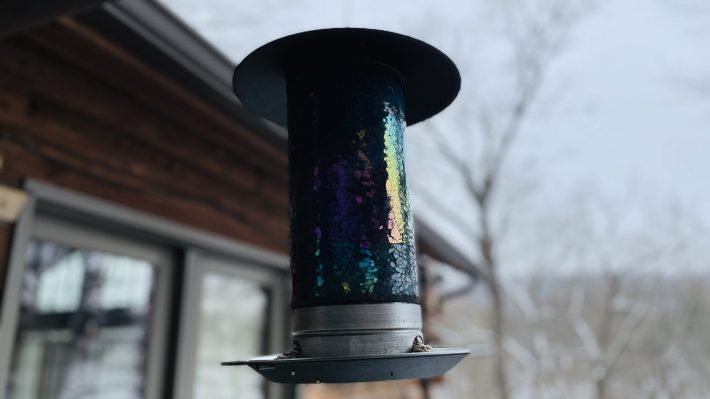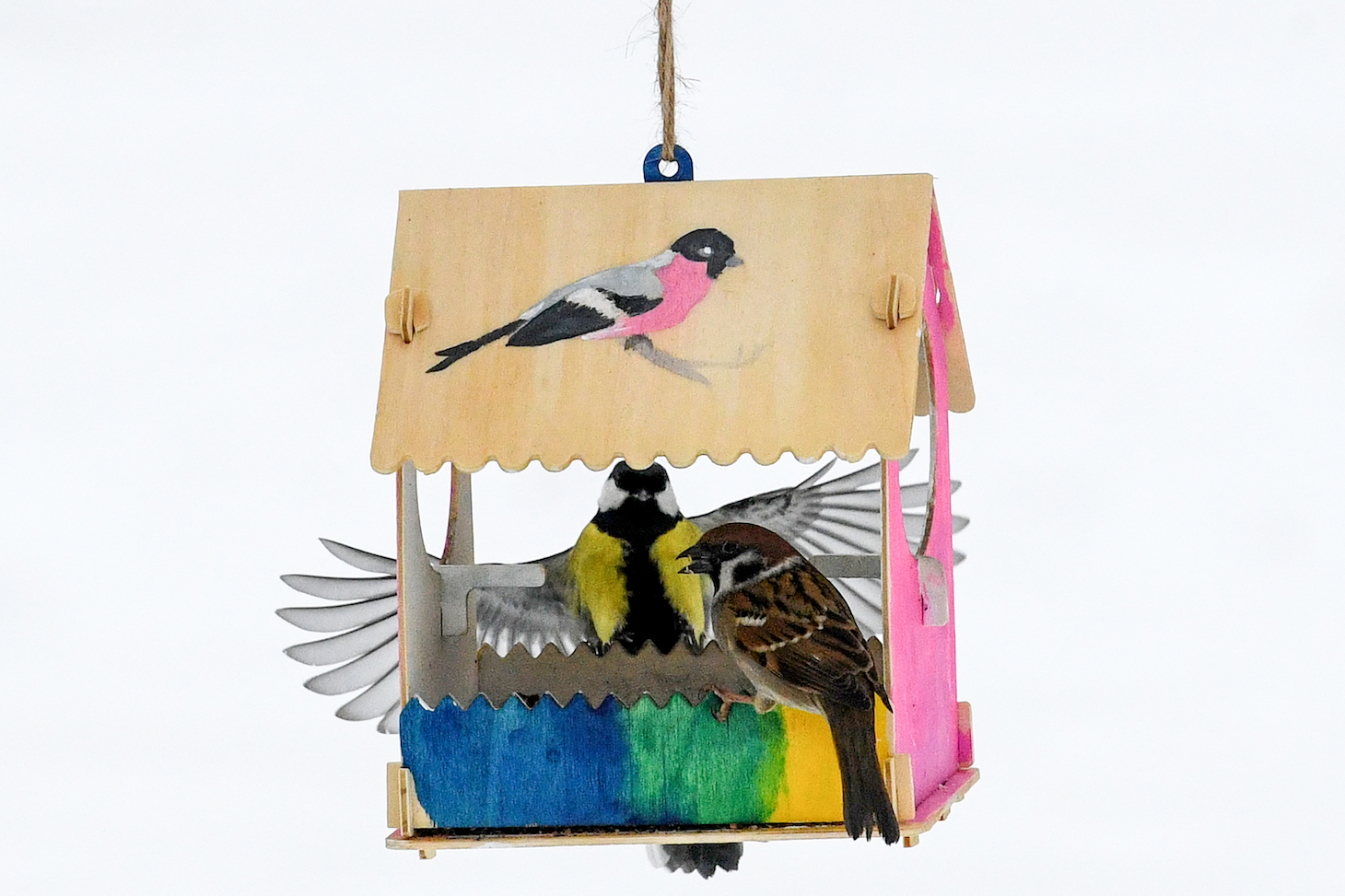There are all different types of bird feeders. My assumption is that some of them—the ugly plastic ones, probably—are the good kind that smart and knowledgeable bird enthusiasts use. Then there are the ones that are pretty to look at, for Bird Idiots such as myself. I can only assume these are bad.
For example: My favorite bird feeder is a cylindrical mosaic of rainbow-colored glass, maybe six inches in diameter, like a colorful and very small grain silo, with three very small arched openings spaced around the bottom. The silo sits on a wide, circular brushed metal tray, a foot across and gently bowl-shaped, with a thin metal rail around the edge of it; you fill the silo with bird food, and some of it comes out of the little openings at the bottom and collects in the tray, and birds perch on the tray or the rail and eat the food, gradually clearing the openings, so that more food comes out. At the top of the silo there's a cone-shaped brushed metal cap, the same diameter as the tray at the bottom. The whole thing is very pretty, and nice to look at. Also the sun glints off the colored glass where it hangs off the southern eave of my roof, and has a disco ball effect on the walls inside the window there.

I bought the feeder on a whim when I saw it, because it was prettier than the others arranged around my house, and because to my way of thinking more bird feeders probably means more birds. In my head there is also a savvy bird-feeder-user shaking their head and going, "You idiot. You absolute goon. By God you'll pay for this." Maybe it's the worst kind of feeder! I have no idea! But this is not the point of this blog. None of this so far has been the point of the blog.
All different types of birds come to this feeder: Red-headed house finches and a few of their gold brethren, cute little Carolina chickadees, downy woodpeckers, chipping sparrows and white-crowned sparrows and the odd white-breasted nuthatch and my favorites, tufted titmice. This winter, it has even hosted a few Carolina wrens, impossibly cool-looking birds typically shy about visiting the feeders around here. Last summer a whole flock of rose-breasted grosbeaks spent two weeks having a convention at this feeder on their way through town.
A Black-capped Chickadee going for the popular sunflower seed + peanut combo meal. pic.twitter.com/2IuBwFWbUF
— Jocelyn Anderson Photography (@JocAPhotography) February 15, 2021
But there was a problem: mockingbirds. Mockingbirds are fine by me. They're cool-looking and Atticus Finch's dad said not to shoot them and it's fun to spot one in a tree in the spring and listen to see what variety of calls you can hear it imitating. But they're a lot larger and heavier than the little songbirds that typically visit the feeder. I noticed they were doing a thing where a big fat mockingbird would land with a big heavy thump on the feeder tray, inevitably splashing some seed around; then it would do an even more obnoxious thing where it would bend down and use its beak and head to plow through the seed in the tray, sweeping huge piles of it overboard, until it found a seed it liked. Then, instead of flying away with the seed, like a cute, coy little tufted titmouse or chickadee would, it would just stand there and eat it, and then repeat the process. For whole minutes it would do this! By the time it flew away it would have eaten four seeds and displaced a thousand. Every mockingbird that visited the feeder would do this. And in the summer, cowbirds (which, like mockingbirds, are way bigger than your friendly neighborhood nuthatch) would also do it. Slobs!
Within a day, these big oafish birds would displace fully a third of the feeder's contents. Within three days or so they'd have dumped nearly a gallon of bird seed into big ugly piles on the patio under the feeder. I'm sure the ground-feeding birds, the dark-eyed juncos and white-throated sparrows and mourning doves, were glad for this. But I'm also sure the squirrels and mice and assorted disgusting vermin also appreciated it. Moreover, it meant that huge quantities of bird food, instead of feeding adorable little songbirds on the feeder where I could see them through the window, were spoiling on the wet floor (and/or being eaten down there, out of sight). Unacceptable. Bird food is cheaper than human food, but it's not free; and I expect the birds to pay for their meal by being attractive and interesting as they eat it where I can see them.
Maybe you, too, have faced the scourge of finicky slob birds splashing bird seed all over the place instead of eating it, in their search for exactly the food they want! Maybe you too have lost the better part of whole bags of bird food to the fickle tastes of these damn mockingbirds and cowbirds. I am here today to tell you that the problem is not that you bought too lax and indulgent a bird feeder. Or anyway it is not only that. It might just be that you are giving the damn pig birds too much choice. They are shopping for the seed they like, and making a mess, because they have the accursed luxury of choosing.
I promise this is not some kind of metaphor for, like, petite bourgeoisie behavior under capitalism. I'm still just talking about birds and bird food.
A male Red-bellied Woodpecker, a peanut connoisseur, checks for the best 🥜 available. pic.twitter.com/gIGaIERTYO
— Jocelyn Anderson Photography (@JocAPhotography) February 8, 2021
On a vague hypothesis, and because the bag featured an illustration of a tufted titmouse, I bought a bag of sunflower hearts—not "songbird mix" or "fruit and nut mix" or "birdwatcher mix" or whatever, but just straight sunflower hearts—and filled the feeder with it. And an amazing thing happened! For hours afterward, the entire area around the feeder was a frenzy of excited bird activity: Birds in numbers I hadn't seen since midsummer thronged to this damn thing to get some of that sweet, sweet sunflower-heart action. Every variety of bird I'm used to seeing in the winter showed up, including the mockingbirds. It was a feast, an absolute madhouse—and at the end of it, the feeder had emptied by virtually no appreciable amount.
Is that because the birds were only pretending to eat the sunflower hearts? Is it because they were checking out the sunflower hearts and then going "Ew, gross, no way"? Absolutely the hell not. I watched them gorging themselves. They loved the damn sunflower hearts. But the thing is, even hungry birds are still birds: they do not eat a lot. Even a relatively big (for bird-feeder traffic) bird like a cardinal or cowbird or mockingbird can stuff itself on an amount of bird food that would fit comfortably in the upturned cap of a soda bottle. The difference is, each bird is only displacing the amount of seed it actually eats, now. The difference is that there is nothing to shop for, and therefore no inducement toward pickiness and selectivity! The difference is, the birds have been liberated from the corrosive narcotizing illusions of consumeri—
No. Birds. This is a blog about birds.
A Red-bellied Woodpecker is startled by a bold Tufted Titmouse. Black-capped Chickadees check out the snack situation as well. Everyone did end up getting a bite to eat! pic.twitter.com/mWfmioLmjy
— Jocelyn Anderson Photography (@JocAPhotography) February 14, 2021
Anyway, now that I have unlocked this new level of bird feeding, I am very excited about it. I filled another feeder with straight nyjer seed, which I'm told is popular among goldfinches and indigo buntings, very pretty songbirds that only rarely show themselves around my house (and which, it must be said, have not shown themselves at this feeder yet). I may fill yet another with unsalted, dry-roasted peanuts. Or mealworms! Or safflower! Or dried fruit chunks! Who will dare stop me.
So consider filling your bird feeder with one single type of bird food. Soon, possibly as soon as when I scroll down to read the comments under this blog, I will learn exactly how this is wrong and terrible. Alternatively I will learn how idiotic it was of me to take this long to learn what others regard as the most obvious and indeed only responsible practice of bird-feeder deployment. But between now and then, I will watch the birds enjoy their sunflower hearts, tidily.






